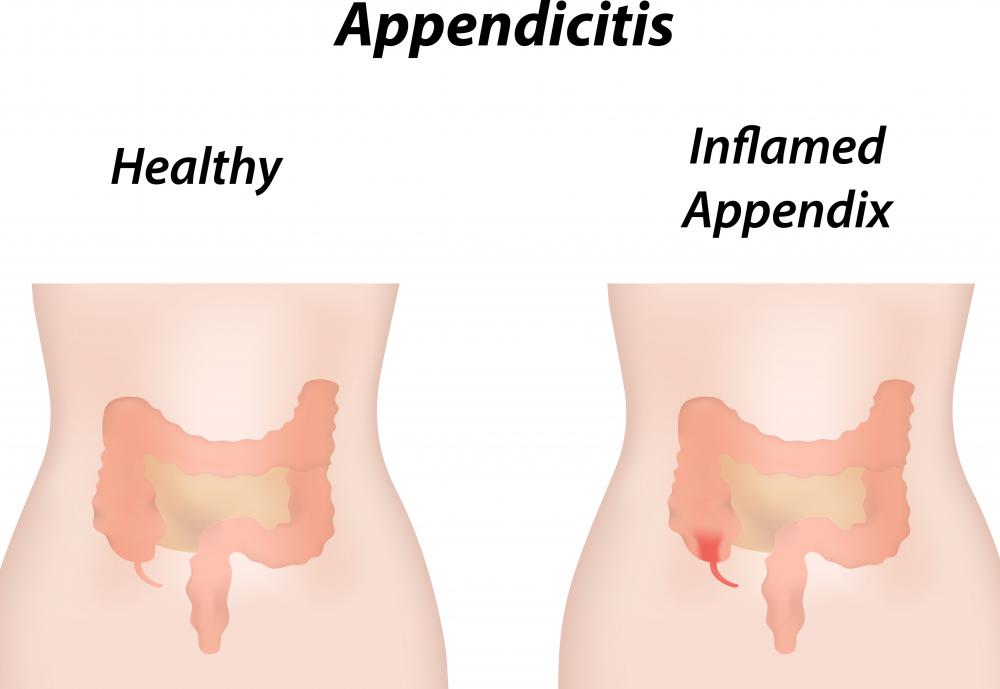At TheHealthBoard, we're committed to delivering accurate, trustworthy information. Our expert-authored content is rigorously fact-checked and sourced from credible authorities. Discover how we uphold the highest standards in providing you with reliable knowledge.
What is the Abdomen?
The abdomen is that part of the torso which lies between the diaphragm and the pelvis. It is commonly referred to as the stomach, belly or "tummy." Inside the abdominal cavity are a number of important organs, including the liver, pancreas, spleen and kidneys. A large part of the digestive tract is also found there, including the stomach, and the small and large intestine. The aorta, a major artery, runs vertically through the abdominal cavity.
Separating the upper abdomen from the chest is the diaphragm, a dome-shaped muscular wall involved in respiration. Below, the lower abdomen is continuous with the pelvis. At the front, the abdomen consists of layers of muscles which make up the abdominal wall. The rear abdominal wall is made up of muscles of the back, together with part of the spine. Externally, the abdomen is covered in skin with an underlying layer of fat.

The navel or umbilicus, a scar where originally the umbilical cord was attached to the fetus, is usually found in the midline of the abdomen and can often become infected due to poor hygiene. Seen from the front, the appearance of the abdominal wall depends greatly upon the condition of the underlying muscles. Poor muscle tone typically results in abdominal protrusion.

Abdominal pain is very common and not usually caused by severe illness. Sometimes extreme pain is felt due to a harmless problem, such as gas inside the gut or a gastrointestinal infection. Alternatively, little or no pain may be associated with serious conditions such as cancer.
Disorders of any of the abdominal organs may give rise to pain. A common example is the appendix, a small pouch in the large intestine which may be infected by bacteria from the gut, becoming inflamed and full of pus. Without treatment, the appendix might burst, releasing its contents into the abdominal cavity to cause a life-threatening condition known as peritonitis.

Correctly diagnosing the abdominal pain associated with appendicitis means that the appendix can be surgically removed, preferably before it bursts. Although symptoms are not always typical, most often the pain begins suddenly in the center of the abdomen and moves, over the next few hours, to an area on the lower right. The pain can be extreme and may be associated with fever, nausea, constipation and a need to pass urine frequently.

A swollen abdomen may be a sign of something normal, such as weight gain or intestinal gas, or might occasionally indicate illness. Fluid accumulating abnormally inside the abdominal cavity is known as ascites. It can occur in liver disease and some cancers, and treatment varies depending upon the cause.
AS FEATURED ON:
AS FEATURED ON:


















Discussion Comments
I had left side pain and from well known experience I know it can be endometriosis, then the scar tissue adhesions it causes and any trauma or procedures. Mine was endometriosis, which caused me to have severe adhesions and adhesions are extremely painful, especially when they twist, kink or block your bowels, or glue like three organs together as one. It was very hard to get a doctor to believe me and I went in for surgery and my spleen, liver, rib cage on my left side were all stuck into my rib cage and abdominal wall. This led to a extremely long surgery of eight hours, mostly to remove the scar tissue to release them as one, and then they had my colon and large bowels all messed up, so now I live with no colon and not a colostomy, but an ileostomy. I always had major constipation as well.
So if a doctor does not believe in you enough to invest in you, then keep on and believe and have faith in God as well, because adhesions are extremely disabling to people who have them as bad as I did and a lot of doctors don't believe the fact that they don't show up on any film, or even an MRI. Unless you need surgery and your bowels are blocked, but mine didn't show up as bad as they were and still are. They never go away and with each surgery come back, but are you supposed to let all your organs be as one and live in extremely disabling pain? I think not. Trust your gut always.
@oceanswimmer: Before I was diagnosed as being lactose intolerant, I would experience pain on the lower left side of my abdomen. My doctor couldn’t figure out what was going on. He sent me to a gastroenterologist who finally determined that I was lactose intolerant.
@oceanswimmer: There are a number of things that could cause lower left side abdominal pain. One of them is (in a female) an ovarian cyst. This can cause excruciating pain. I personally experienced that and it led to my hysterectomy.
It could also be diverticulitis. That often leads to lower left side abdominal pain.
In any case, if you are experiencing abdominal pain, you should immediately seek medical attention.
I know that right lower quadrant abdominal pain is often associated with appendicitis. What if the pain is on the left side?
Post your comments